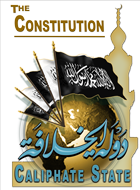 Article 113: In origin men and women are segregated, and do not come together except for a need by Shar’ agreesto it and agrees to their assembly for it , such as trade and the pilgrimage.
Article 113: In origin men and women are segregated, and do not come together except for a need by Shar’ agreesto it and agrees to their assembly for it , such as trade and the pilgrimage.
This article is derived from numerous evidences. Firstly: the Shari’ah divided the Muslim’s life between the general and private spheres, and in the woman’s private life she can display what is above her Awrah to her Maharim (close family relatives), whereas in her public sphere she cannot display anything from her body except her face and hands. Secondly, the Shari’ah made the rows of the woman in prayer behind that of the men. Thirdly, the Shari’ah ordered men to lower their gaze from the women, and vice versa. Fourthly, the woman has been ordered to cover herself in modest clothing which covers every part of the places of adornment, except for that which is apparent from her (in other words, her hands and face). Fifthly, it is permitted for her to display what is above her Awrah in her private life between her Maharim.
All of the evidences for these rules indicate that the basis is that men are segregated from women, and so each of them lives in a different sphere of life than the other. Along with this, the woman has had certain issues made permitted, recommended and obligatory upon her. Therefore, it is imperative that she undertakes what is obligatory, and recommended, and permitted, but without Tabarruj (beautification which attracts attention) and with the clothing which Allah (swt) described in the Quran with His (swt) words
((وَلْيَضْرِبْنَ بِخُمُرِهِنَّ عَلَى جُيُوبِهِنَّ))
“And to wrap [a portion of] their headcovers over their chests.” (TMQ 24:31)is the upper/outer clothing; whereas His (swt) words
((الْمُؤْمِنِينَ يُدْنِينَ عَلَيْهِنَّ مِنْ جَلَابِيبِهِنَّ ))
“Bring down (let down) over themselves their wrapping outer garments.” is referring to the clothing from underneath, because the Jilbab is worn above the clothing. Al-Jawhari said in Al-Sihhah “The Jilbab is the cover and some say it is a sheet”. In the Al-Muheet dictionary it mentions “the Jilbab is in the form of the Sirdab or the Sinmar, which is the gown or a large garment for women under the cover, or conceals her clothing like a cover”. And to “draw” (Idnaa') clothing is to lower it to the bottom; it is said “draw the cover, lower it”, and the meaning of drawing here is lowering, and the only meaning of lowering the clothing is to lower it to the bottom. And His (swt) words
((غَيْرَ مُتَبَرِّجَاتٍ بِزِينَةٍ ))
“Not displaying adornment.” (TMQ 24:60)is with respect to the open display of beautification (Tabarruj).
Therefore, she is allowed to go out dressed in accordance with what the Shari’ah specified for her, and meet with men in order to undertake what the Shari’ah allowed her to do, such as buying, selling, employment, appointing proxies, custody and so on, and to carry out was has been made obligatory upon her such as Hajj and paying the Zakah, or recommended upon her such as voluntary charity, helping the poor, treating the sick and so on. These needs have been confirmed from the legislative angle for her by the Shari’ah, whether they were obligatory, recommended, or permitted, and has confirmed the gathering of men and woman while they are undertaken. Therefore, these evidences indicate that the method of life in Islam is to segregate men from the women in the private sphere, and allow men and women to gather in the public sphere in order to carry out whatever was obligatory, recommended, or permitted upon them with the dress in accordance with what the Shari’ah specified to her. These are the evidences for this article.

